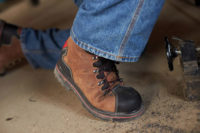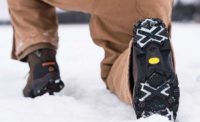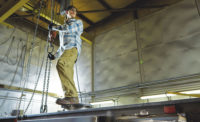
Leonardo da Vinci once called the foot “a masterpiece of engineering and a work of art.” The human foot, after all, contains 26 relatively small bones, more than 150 ligaments and an intricate network of muscles, nerves and blood vessels.
Because one small misstep or accident can cause injuries, choosing the right footwear is essential. How fitting, then, that today’s protective footwear can be seen as masterpieces of engineering where advances in technology and performance provide the foundation necessary for safety and comfort.
Where do you begin?
The selection process starts with knowing your needs and understanding how to meet them. Because today’s continually evolving market offers more and more options, making a selection is no simple challenge. The following list serves as a crash course in the vocabulary of today’s safety footwear.
• ASTM-certified: The American Society for Testing and Materials (ASTM) provides the standards for the level of protection required in safety footwear.
• Steel-toe: These offer maximum toe protection from sudden impact or compression and must meet or exceed ASTM standard F2415-05. They are typically made from non-corrosive steel and are a necessity for any job where there is the risk of significant toe injury.
• Composite-toe: Modern composite toes are metal-free and lightweight while still satisfying ASTM standards. Some brands even have proprietary technologies including non-metallic composite toes that are resistant to heat and cold, non-conductive, and lighter than traditional steel toes while still satisfying ASTM safety standards.
• Metatarsal guard: A metatarsal guard (also known as a met-guard) provides additional protection to the instep area. This guard is either permanently attached to the exterior of the work shoe or can be built into the footwear itself (known as an internal met). Traditionally this is needed in work environments where there is a high risk of falling objects or of items rolling onto the instep of a worker’s foot.
• Static-dissipating (ESD): In areas where the generation of static electricity could harm sensitive electrical equipment or ignite flammable materials, safety footwear needs to be electrostatic- dissipating. ESD footwear allows small charges of static electricity to be continuously dissipated into the walking surface, thereby reducing the accumulation of potentially harmful levels of static electricity. These shoes should never be worn in areas where there are open circuits or highly charged equipment as they will do little to protect the wearer from potentially dangerous electrical charges (see EH below).
• Electrical hazard (EH): When workers may come into contact with live circuits, wires or highly charged electrical equipment, safety footwear with an EH rating provides a secondary source of protection from electrical shock. This protection comes from insulating properties that stop a current from being grounded for any significant length of time.
• Fiberglass shank: This is a lightweight option to the steel shank for arch support. Built under the arch, it offers increased stability and durability without adding weight.
• Oblique toe: This option offers a boxier toe compartment and provides increased comfort and overall fit for individuals with large or wide feet.
• Waterproofing: Certain work environments make waterproof footwear a necessity. The most reliable and durable products on today’s market feature waterproof leather combined with a waterproof membrane (e.g., Gore-Tex) within the boot that keeps moisture out while allowing for air ventilation and circulation.
• Rubber outsole: Because genuine rubber offers excellent performance in terms of the abrasion, oil and slip-resistant qualities valued in a work boot, it is the most common outsole material used in work footwear. Vibram®, a high-performance rubber and an excellent choice for work sites with rugged terrains, provides maximum traction on both wet and dry surfaces.
• TPU outsole: Outsoles made from thermoplastic polyurethane are long-wearing and resistant to abrasion, oil and chemicals. Designed to be tough, they typically resist splitting and are more lightweight than their rubber counterparts.
• PU outsoles: Polyurethane outsoles provide a lightweight, flexible and comfort- enhancing option to the typical rubber outsole while still providing abrasion-, slip- and oil-resistant qualities.
• Midsole: A boot’s midsole is designed to disperse weight or provide stability for the foot. Work footwear midsoles are either made from PU (polyurethane) or EVA (ethylene vinyl acetate). PU is the premium cushioning material while EVA offers similar performance characteristics (it is used in most athletic footwear). PU tends to be more durable while EVA tends to be more lightweight; a choice between the two generally depends on end use.
• Cement construction: The manner in which boots are constructed makes a difference in weight, flexibility and longevity. Cement construction indicates that outsole/midsole are cemented permanently to the upper, making the boot lightweight and flexible.
• Direct attach: Direct attach (or injection) is a boot construction where the sole material is permanently and chemically fused or attached to the upper. This construction is very lightweight and is generally the most durable and flexible type of construction. It also has the added benefit of being watertight.
• Goodyear® welt construction: Goodyear® welt construction provides durability as the upper and inner sole are stitched together with a strip or ‘welt.’ The sole is then stitched through the welt. This process allows boots to be re-soled or repaired, thus extending their longevity.
• Opanka construction: Opanka construction (or side stitch) is when an upper is directly sewn to the outsole. This unique construction is achieved by hand-sewing the upper, sock lining and outsole in a single process, delivering the maximum in comfort and flexibility.
Purchasing and maintaining footwear
Now that you’ve expanded your footwear vocabulary, here are some things to consider when purchasing your next pair of boots:
• Time of day matters. Because feet swell somewhat throughout the day, be sure to shop for boots in the afternoon or early evening. By going later in the day you’ll be more likely to select a size that will always feel comfortable, even when you’re on your feet for a 12-hour day.
• Socks matter. Bring a well-padded pair of socks that you would normally wear for a day of work. There are a number of great socks on the market that have moisture wicking and anti-microbial properties as well as specialized cushioning for better fit and feel.
• Know the requirements. Before shopping check with your employer to see if you should select specific features like static dissipating or steel-toe vs. composite.
• Do your research. Today’s market is full of great brands with innovative comfort and performance technologies. By doing a bit of research beforehand, you can target exactly what you’re looking for.
• Look for comfort. While protection is vital, boots should also feature a comfort system that will help reduce tired feet for long days of work. Shoes featuring compression pads or comfort gel soles help to reduce impact, return energy and provide all-day comfort. Brands today often incorporate Ortholite® or other removable insoles that provide additional cushion and antimicrobial properties to help reduce odors.
Remember that the job doesn’t end at point of purchase. Aftercare is important for extending the life of your boots. Treating leather with mink oil or a waterproof leather treatment will keep the material supple, flexible and resistant to moisture. Storing leather boots in a clean, dry place with adequate ventilation will also help preserve the leathers and reduce odors. With proper research and information, workers can take the first step in protecting their feet and ensuring better safety on the job.


